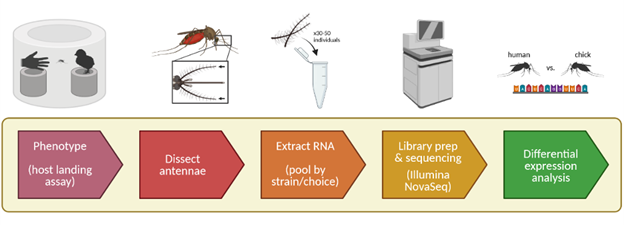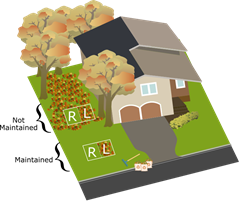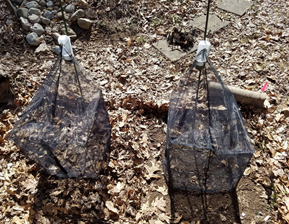|
Research-In-Progress talks are important opportunities for entomology graduate students to develop the communication skills necessary to become researchers in entomology and related disciplines. At the first research-in-progress talks of the spring 2023 semester, three graduate students presented their research, which cover different subfields of entomology: Theresa Menna, a 2nd-year Biological Sciences-CBBG PhD student in the Fritz Lab, Minh Le, a 2nd-year Entomology PhD student in the Pick Lab, and Max Ferlauto, a 4th-year Entomology PhD candidate in the Burghardt lab. Why do mosquitoes choose to bite humans? Each year, 700,000 deaths occur due to mosquito-borne disease [1]. Mosquitoes transmit infectious disease between humans and other vertebrates, including chikungunya, dengue, zika, malaria, and West Nile fever (WNF) [1]. Transmission of a pathogen or parasite occurs when mosquitoes feed upon the blood of vertebrate hosts. A primary objective of Menna’s research is to characterize the genetic basis for host preference using the northern house mosquito, Culex pipiens. The northern house mosquito is found worldwide and is the primary vector for WNF in North America. The northern house mosquito has two biological forms, pipiens and molestus. These forms are distinguished by their host preference: the pipiens ecotype prefers avian hosts while the molestus ecotype prefers human hosts. Hybrids of these two forms have indiscriminate host preference, and thus are more willing to feed on both the bird reservoirs of WNF and humans, resulting in human WNF infections. To locate their hosts, mosquitoes use a range of senses including olfaction via appendages such as the antennae and proboscis. An odorant, if non-water soluble, will pass through the sensillum lymph on the antennae and get transported by odorant-binding proteins (OBPs) to odorant receptors (ORs). Based on this knowledge, the Fritz lab performed antennal RNA sequencing (RNAseq) to identify OR, OBP and other chemosensory genes involved in host preference. To identify mosquitoes with specific host preferences (avian or human), they used a host landing assay, dissected antennae, extracted their RNA, and performed differential gene expression analysis using RNAseq for human and avian-seeking mosquitoes (Fig. 1). Menna was able to identify several candidate OBPs and OR genes, whose expression differed for groups with distinct host preferences. In the future, Menna hopes to perform functional studies to determine their role for host preference and further understand how mosquitoes transmit disease. From an egg to an insect: the evolutionary changes driving insect development Insects are one of the most diverse taxa and one of its defining characteristics is its conserved segmented body plan. All insects have a segmented body with three regions: the head, thorax, and abdomen. In the 1980’s genetic screens were performed in the fruit fly Drosophila by nobel laureates Nüsslein-Volhard and Wieschaus, in which they created mutants by disrupting segmentation [2]. These studies revealed which genes are necessary for generating a segmented insect and uncovered a genetic network that controls the segmentation process. Since then, it has been found that these genes encode transcription factors, or DNA-binding proteins, that work within a network to regulate gene expression. To work within this network, transcription factors use short functional amino acid sequences within a protein, also known as short linear motifs. Le’s goal is to determine how these short linear motifs have evolved to drive differences in insect development. To predict motif evolution in the transcription factors necessary for insect segmentation, Le used MEME Suite, an online portal for motif analysis [3]. By inputting homologous protein sequences into MEME, a program for identifying motif evolution, Le found conservation of these short linear motifs in certain groups of insects, but not in others, suggesting the function of these motifs evolved. Le then performed functional tests using Drosophila to test whether these motifs are functional. Le hopes to use the same methods to look at novel motif evolution in transcription factors involved in insect development across different insect orders. . Understanding the effects of leaf litter management on overwintering insects Imagine a brisk, fall afternoon, and the leaves from the oaks, dogwoods, and maples begin to fall onto the soft grass. Many of us rush outside with our rakes and yard waste bags, ready to clean it up. Every year, we remove 35 million tons of yard waste, much of it leaf litter from residential areas. [4]. However, we neglect to consider that many insects that help maintain healthy ecosystems are contained within leaf litter. Max Ferlauto studies how residents manage their leaf litter and its impacts on insect habitat. Ferlauto discussed results from his two-year residential study, which asked the following questions: What is the role of leaf litter in protecting the more vulnerable, dormant life stages of insects? Can keeping leaf litter in your yard provide an insulating “blanket” and improve overwintering insect habitat? Ferlauto recruited volunteers from 20 residential homes and removed or retained leaf litter from areas of different yard management intensities: unmaintained or maintained zones (Fig. 2). The following spring, he installed emergence traps (Fig. 3) over each treatment. He collected emerging insects from these traps every week in the spring, which he brought back to the lab to quantify emerging insects. Ferlauto found that in both years, more butterflies and moths emerged from maintained areas compared to unmaintained areas and that they emerged more from the plots in which leaf litter was kept in both maintained and unmaintained areas. In addition, he found that removing your litter every year increases variability in soil temperature. Therefore, leaf litter may serve as an insulatory blanket that provides a buffer to dormant insects, who would be otherwise unable to manage sudden temperature changes. Through Ferlauto’s research, homeowners can make better management decisions when deciding to keep or remove leaf litter. In addition, ecologists can use this knowledge to better understand how to care for the vulnerable life stages of overwintering insects. References:
[1] “Vector-Borne Diseases”. World Health Organization. https://www.who.int/news-room/fact-sheets/detail/vector-borne-diseases. [2] Nüsslein-Volhard, C., Wieschaus, E. Mutations affecting segment number and polarity in Drosophila. Nature 287, 795–801 (1980). https://doi.org/10.1038/287795a0 [3] Bailey TL, Boden M, Buske FA, Frith M, Grant CE, Clementi L, Ren J, Li WW, Noble WS. MEME SUITE: tools for motif discovery and searching, Nucleic Acids Research, Volume 37, Issue suppl_2, 1 July 2009, Pages W202–W208, https://doi.org/10.1093/nar/gkp335 [4] EPA. (2018). Advancing Sustainable Materials Management: 2018 Fact Sheet. Environmental Protection Agency. Authors: Ebony Michelle Argaez is a MS student in the Pick Lab studying the effectiveness of RNAi in the milkweed bug, Oncopeltus fasciatus. Twitter: @em_argaez Brendan Randall is a second year PhD student in the Burghardt lab studying the effects of rhizobial diversity on plant-insect interactions and insect community dynamics. Comments are closed.
|
Categories
All
Archives
June 2024
|
Department of Entomology
University of Maryland
4112 Plant Sciences Building
College Park, MD 20742-4454
USA
Telephone: 301.405.3911
Fax: 301.314.9290
University of Maryland
4112 Plant Sciences Building
College Park, MD 20742-4454
USA
Telephone: 301.405.3911
Fax: 301.314.9290




 RSS Feed
RSS Feed




